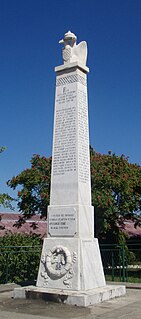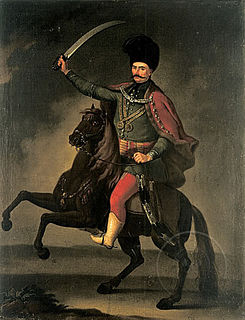
Sremski Karlovci is a town and municipality located in the South Bačka District of the autonomous province of Vojvodina, Serbia. It is situated on the bank of the river Danube, 8 kilometres from Novi Sad. According to the 2011 census results, it has a population of 8,750 inhabitants. The town has traditionally been known as the seat of the Serbian Orthodox Church in the Habsburg Monarchy, as well as political and cultural capital of Serbian Vojvodina after the May Assembly and during the Revolution in 1848.

János Damjanich was an Austrian military officer of Serb origin who became general of the Hungarian Revolutionary Army in 1848. He is considered a national hero in Hungary.

Rascians was an exonym in the early modern period that designated Serbs of the Habsburg Monarchy, and in a wider perspective other related South Slavic ethnic groups of the Monarchy, such as the Catholic Bunjevci and Šokci. The term was derived from the "Raška" (Rascia), a medieval Serbian region and exonym of the medieval Serbian state in Western sources. Because of the large concentration of Serbs in the southern Pannonian Plain, this region was called Rascia, today encompassing territories of Serbia (Vojvodina), Croatia, Hungary and Romania.

Danilo Šćepčević was the Metropolitan of Cetinje between 1697 and 1735. He styled himself "vojevodič srpskoj zemlji".

Arsenije III Čarnojević was the Archbishop of Peć and Serbian Patriarch from 1674 to his death in 1706. In 1690, he led a large migration of Serbs from Ottoman Serbia into the Habsburg Monarchy, and this is when the Ottomans stopped recognising him, creating a rival patriarchate. He is also remembered for attempting to get a publishing licence from the Habsburg authorities to print Serbian books but to no avail.
Anthony Bagaš was a Serbian nobleman from Kastoria who retreated to Mount Athos in between 1356 and 1366, where he later bought and restored the ruined Athonite monastery of Saint Paul with the help of Nikola-Gerasim Radonja in the 1380s, becoming its abbott - taking the monastic name Arsenios (Arsenije). The two were successful in receiving donations from both the Byzantines and Serbs, and refurbishing the monastery with revenue from Serbian silver and gold mines, making it one of the major Serbian monasteries. He translated hagiographical works into Serbian.

Jovan Monasterlija was a Serbian vice-voivode (podvojvoda) and Austrian imperial officer that led a Serbian Militia against the Ottoman Empire and other enemies of the Austrian Emperor. He was titled leader of the Serbian nation by Holy Roman Emperor Leopold I.
Toma Raspasani was an Albanian Franciscan friar and vicar, subordinate Pjetër Bogdani, Archbishop of Skopje, with whom he organized an Albanian pro-Austrian movement that would fight in the Great Turkish War against the Ottoman Empire.
Vuk Isaković was a Serb military commander in Austrian service during the Austrian-Ottoman Wars. He was the inspiration for the main character, Vuk Isakovič, in the Seobe.
Antonije Znorić was a military officer (colonel) of the Habsburg army and the commander of the Serbian Militia during the Great Turkish War.

Arsenije IV Jovanović Šakabenta was the Archbishop of Peć and Serbian Patriarch from 1725 to 1737 and Head of the Serbian Orthodox Church in Habsburg Monarchy from 1737 to his death in 1748.
Avram Miletić was a merchant and writer of epic folk songs who is best known for writing the earliest collection of urban lyric poetry in Serbian language between 1778 and 1781.

Arsenije Loma was a Serbian voivode in the First and Second Serbian Uprising of the Serbian Revolution (1804–1817). He had the rank of buljubaša and was appointed by Karađorđe to command Kačer in 1811.
The Serbian Hussar Regiment was a military unit of the Russian Imperial Army which predominantly consisted of Serbian colonists to Russia.
Sečujac is a Serbian surname. It may refer to:

The Serbian Free Corps, known simply as frajkori, was a volunteer militia composed of ethnic Serbs, established by the Habsburg Monarchy, to fight the Ottoman Empire during the Austro-Turkish War (1787–91). The conflict with Turkish forces ultimately proved inconclusive. The rebellion in the Sanjak of Smederevo and militia's operations resulted in the period of Habsburg-occupied Serbia, which took place from 1788 to 1792. Ultimately, the Serbian volunteer corps had the legacy of promoting the creation of future paramilitaries, such as during the First Serbian Uprising.

Bogić Vučković Stratimirović was a rebel leader in the Sanjak of Herzegovina who organized an uprising in 1737, during the Austro-Russian–Turkish War (1735–39). He was from the Trebinje hinterland, in Herzegovina, the son of Vučko Petrović and grandson of Petar Stratimirović. Early on, he moved to the Kingdom of Serbia (1718–39). He is mentioned in documents as a merchant from Kragujevac. He bought an attestation from the Republic of Ragusa that he descended from Stracimir Balšić, the Lord of Zeta, then appeared in autumn 1737 at the Habsburg deputy commander's office in Sremski Karlovci, with Aleksa Milišević, presenting themselves as nobility and Vučković stressed that he had readied the Montenegrin peoples to help the Austrian Emperor. Vučković and his brothers organized an uprising in Herzegovina in 1737 during Austrian-Turkish conflicts in the Balkans, at the same time helping the Austrians. After the Capture of Belgrade (1739), for their efforts, he and his brothers were awarded Austrian noble titles and granted the village of Kulpin which they settled. They adopted the coat of arms of the medieval Kosača.
The Serb Uprising of 1737–39 broke out following Austria's defeats against the Ottomans, when the Austrian Emperor issued proclamations that the Christians in the Balkans rise against the Ottoman Empire. The Austrian Emperor called on the Serbs, who were ready to revolt, on 15 June 1737, and stressed that they would fight in an alliance with Russia against a common enemy. The Serbs organized themselves under Serbian Patriarch Arsenije IV. The uprising had a wide geographical extent, from Belgrade to eastern Bosnia and Herzegovina, Montenegro and the Šar Mountain. The Albanian Klimenti tribe also joined the uprising. The failed war prompted Serbs, mostly from Herzegovina, Sandžak, Metohija and Montenegro, to flee under the leadership of Arsenije IV from the Ottoman territories into the Habsburg Monarchy.










